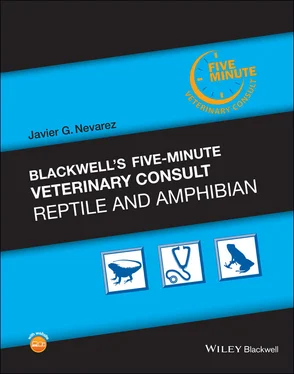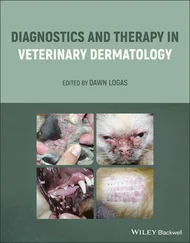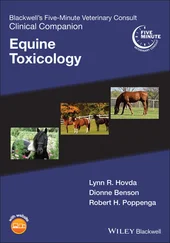No age or sex predisposition
Diarrhea
Tenesmus
Inappetence
Weight loss
Improper husbandry
Immunocompromised animals with active parasitic/bacterial infections are more predisposed for the protozoan to become pathogenic.
 DIAGNOSIS
DIAGNOSIS
DIFFERENTIAL DIAGNOSIS
Nyctotherus sp.
Microscopic evaluation of fresh fecal material to visualize trophozoites and cysts.
SAF technique can be used for better visualization.
The addition of iodine will stain the contents of the cysts, making them more visible.
Hemorrhagic necrotizing colitis
 TREATMENT
TREATMENT
APPROPRIATE HEALTH CARE
N/A
N/A
CLIENT EDUCATION/HUSBANDRY RECOMMENDATIONS
Practice proper hygiene
Wash fruits and vegetables before being fed
House infected animals separately
 MEDICATIONS
MEDICATIONS
DRUG(S) OF CHOICE
Metronidazole 50 mg/kg PO q24h for 7 days
Nimorazole 125 mg/kg PO q24h for 4 days
Tetracyclines 5–10 mg/kg q24h for 5–8 days
N/A
 FOLLOW‐UP
FOLLOW‐UP
PATIENT MONITORING
Recheck feces on a routine basis
EXPECTED COURSE AND PROGNOSIS
Treatment should only be started if clinical disease is observed.
 MISCELLANEOUS
MISCELLANEOUS
COMMENTS
N/A
Balantidium coli is the only known species to infect humans.
N/A
SAF = sodium acetate acetic acid formalin
De Bosschere H, Roels S. Balantidium sp. and Nyctotherus sp.: Two common members of the digestive‐tract flora in Mediterranean tortoises. Tortoise Trust. https://www.tortoisetrust.org/articles/balantidium.htm
Divers SJ. Parasitic Diseases of Reptiles. MSD Manual Veterinary Manual, June 2020. http://www.merckvetmanual.com/exotic‐and‐laboratory‐animals/reptiles/parasitic‐diseases‐of‐reptiles
1 Hnizdo J, Pantchev N., eds. Protozoa (digestive tract). In: Medical Care of Turtles and Tortoises: Diagnosis, Surgery, Pathology, Parasitology. Frankfurt, Germany: Edition Chimaira; 2011:194–195
2 Jacobson ER. Parasites and parasitic diseases of reptiles. In: Jacobson ER, ed. Infectious Diseases and Pathology of Reptiles: Color Atlas and Text. Boca Raton, FL: CRC Press; 2007:571–666.
3 Rataj AV, Lindtner‐Knific R, Vlahovic K, et al. Parasites in pet reptiles. Acta Vet Scand 2011; 53(1):33.
AuthorElsburgh O. Clarke III, DVM, DACZM
Buphthalmos
 BASICS
BASICS
DEFINITION/OVERVIEW
Buphthalmos is an enlarged globe that is positioned normally in the socket.
An increase in IOP causing enlargement and distention of the globe secondary to chronic glaucoma.
There is no standard signalment for this disease.
Common findings in the history may include tearing and squinting noted by the owners, as well as an asymmetry of the globes and loss of vision on the affected side(s).
While buphthalmos can be bilateral, most cases in chelonians are unilateral.
The corneal diameter of the affected eye is increased due to globe stretching.
There may be blepharospasm and epiphora.
Unlike exophthalmia, the conjunctiva and position of the nictitans is usually normal.
There may be red ciliary flush (red ring around the cornea) and congested episcleral vessels.
There may be lens luxation and/or cataracts in the affected eye(s).
Retropulsion of the globe is normal but the globe itself may feel firmer than normal.
Diet and environmental factors are likely to have an effect on the development of cataracts.
Cataract development in brumating tortoises has been associated with damage from freezing temperatures.
Trauma, especially if there is corneal penetration, can induce uveitis and cataract formation.
The presence of a cataract may increase the chance of lens luxation and/or lens induced uveitis, both of which can lead to glaucoma.
 DIAGNOSIS
DIAGNOSIS
DIFFERENTIAL DIAGNOSIS
It is important to first differentiate between exophthalmia and buphthalmos.
Glaucoma in chelonians is usually secondary to outflow obstruction of the aqueous humor, which is most often caused by uveitis, lens luxation, or intraocular neoplasia.
Physical examination findings should raise suspicion of buphthalmos, which is confirmed by finding elevated IOP.
Normal IOP in three tortoise species has been reported to be 15.74 ± 0.2 mm Hg (Testudo hermanni), 14.2 ± 1.2 mm Hg (Geochelone denticulata), and 15.3 ± 8.81 mm Hg (Geochelone carbonaria) and in six turtle species at 5.42 ± 0.96 mm Hg (Emys orbicularis), 6.7 ± 1.4 mm Hg (Terrapene sp.), 8.3 ± 1.5 mm Hg (Terrapene sp.), 5.42 ± 1.7 mm Hg (Trachemys scripta elegans), 10.02 ± 0.66 mm Hg (Trachemys scripta elegans), 6.5 ± 1.0 mm Hg (Lepidochelys kempii), 3.8 ± 1.1 mm Hg (Lepidochelys kempii), and 4–9 mm Hg (Caretta caretta).
Since most cases are unilateral, a significant difference in IOP between the eyes may be most indicative of a problem.
Ocular examination and ultrasound are helpful in further evaluating the root cause, although the scleral ossicles can limit visualization.
Chronically elevated IOP will lead to pain and blindness.
 TREATMENT
TREATMENT
Читать дальше

 DIAGNOSIS
DIAGNOSIS TREATMENT
TREATMENT MEDICATIONS
MEDICATIONS FOLLOW‐UP
FOLLOW‐UP MISCELLANEOUS
MISCELLANEOUS BASICS
BASICS










